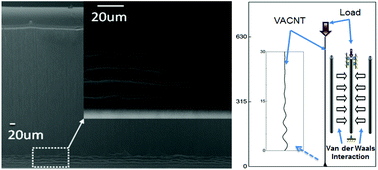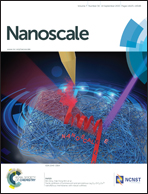Understanding the nanoscale local buckling behavior of vertically aligned MWCNT arrays with van der Waals interactions†
Abstract
The local buckling behavior of vertically aligned carbon nanotubes (VACNTs) has been investigated and interpreted in the view of a collective nanotube response by taking van der Waals interactions into account. To the best of our knowledge, this is the first report on the case of collective VACNT behavior regarding van der Waals force among nanotubes as a lateral support effect during the buckling process. The local buckling propagation and development of VACNTs were experimentally observed and theoretically analyzed by employing finite element modeling with lateral support from van der Waals interactions among nanotubes. Both experimental and theoretical analyses show that VACNTs buckled in the bottom region with many short waves and almost identical wavelengths, indicating a high mode buckling. Furthermore, the propagation and development mechanism of buckling waves follow the wave damping effect.


 Please wait while we load your content...
Please wait while we load your content...